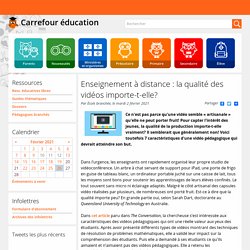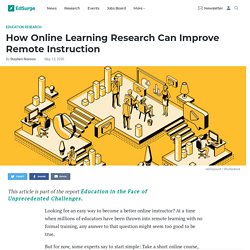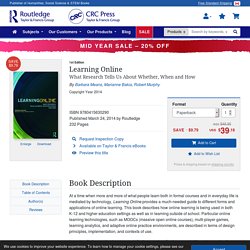

Enseignement à distance : la qualité des vidéos importe-t-elle? Dans l’urgence, les enseignants ont rapidement organisé leur propre studio de vidéoconférence.

Un arbre à chat servant de support pour iPad, une porte de frigo en guise de tableau blanc, un ordinateur portable juché sur une caisse de lait, tous les moyens sont bons pour soutenir les apprentissages de leurs élèves confinés. Le tout souvent sans micro ni éclairage adaptés. Malgré le côté artisanal des capsules vidéo réalisées par plusieurs, de nombreuses ont porté fruit.
Est-ce à dire que la qualité importe peu? En grande partie oui, selon Sarah Dart, doctorante au Queensland University of Technology en Australie. Dans cet article paru dans The Conversation, la chercheuse s’est intéressée aux caractéristiques des vidéos pédagogiques qui ont une réelle valeur aux yeux des étudiants. 1. Peut-être pour se rapprocher d’une véritable relation maître-élève, les jeunes préfèrent que leur enseignant utilise un ton plus familier, comme s’il s'adressait à eux dans un échange verbal. Online blended learning planning workbook Oct2016. Multimodal Learning Through Media (1) How Online Learning Research Can Improve Remote Instruction. Looking for an easy way to become a better online instructor?

At a time when millions of educators have been thrown into remote learning with no formal training, any answer to that question might seem too good to be true. But for now, some experts say to start simple: Take a short online course, for example, to see what students experience. (The in-depth workshop or multi-day training can come later.) “It’s one of the easiest things to do to really understand what that environment looks like, feels like and behaves like,” says Kerry Rice, a professor at Boise State University who has studied effective online learning. If nothing else, the experience of learning online can alter a teacher’s perspective, which is a crucial first step toward improving practice. “But too often, when teachers go into webinars or workshops [offered by] their school or district, it rarely connects with the direct needs they have in the classroom that moment,” she says. Learning Online: What Research Tells Us About Whether, When and How -
"[The authors] discuss four major trends in online learning in higher education - "self-paced, adaptive instruction and competency-based learning; blended learning; learning analytics; and MOOCs".

For K-12 schools, they define blended learning as "the use of online learning in conjunction with traditional teacher-led forms of instruction", which may increase "the amount of time during which students are actively engaged in learning". The authors suggest that "technology-enabled self-initiated learning will one day displace formal learning", blended learning serves as "part of a systemic approach to improving developmental education", and online universities and schools point "the way towards efficiencies and improvements that more traditional institutions are likely to adopt".
Summing Up: Recommended" - D.L. Contributions thématiques. 201015 Cnesco Numerique Tricot Chesne Rapport synthese. Osez l'innovation pédagogique en formation. OwnCloud. Enseignement à distance : Promesses non tenues ?
Edtech. Ingénierie pédagogique. Enseignement à distance. Intelligence artificielle. Le numérique en classe. Serious games. Classe inversée. Croyez-vous vraiment que votre école innove avec le numérique ? Un article qui, d’entrée de jeu, vous interpelle directement avec son interrogation : « Croyez-vous vraiment que votre école innove avec le numérique ?

Réévaluez –vous avec ces 6 questions directes »… de la plume d’Alan November, par surcroît… y’en fallait pas plus pour m’accrocher. Ce sont des questions directes d’Alan November, sommité reconnue dans le domaine de l’éducation et de la technopédagogie, qui invitent à une introspection chez les leaders scolaires et chez les enseignants; elles veulent aider à 1. clarifier quelle est la valeur ajoutée d’un environnement numérique pour l’apprentissage et 2. déterminer si les activités d’apprentissage offertes font bon usage de cet environnement. “If you answer no to all six questions when evaluating the design of assignments and student work, then chances are that technology is not really being applied in the most innovative ways.”
Bon, z’êtes prêts ? Un moment d’évaluation formative/diagnostique pour leaders et enseignants, genre. WordPress: